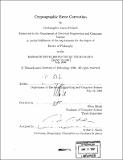Cryptographic error correction
Author(s)
Peikert, Christopher Jason
DownloadFull printable version (4.770Mb)
Other Contributors
Massachusetts Institute of Technology. Dept. of Electrical Engineering and Computer Science.
Advisor
Silvio Micali.
Terms of use
Metadata
Show full item recordAbstract
It has been said that "cryptography is about concealing information, and coding theory is about revealing it." Despite these apparently conflicting goals, the two fields have common origins and many interesting relationships. In this thesis, we establish new connections between cryptography and coding theory in two ways: first, by applying cryptographic tools to solve classical problems from the theory of error correction; and second, by studying special kinds of codes that are motivated by cryptographic applications. In the first part of this thesis, we consider a model of error correction in which the source of errors is adversarial, but limited to feasible computation. In this model, we construct appealingly simple, general, and efficient cryptographic coding schemes which can recover from much larger error rates than schemes for classical models of adversarial noise. In the second part, we study collusion-secure fingerprinting codes, which are of fundamental importance in cryptographic applications like data watermarking and traitor tracing. We demonstrate tight lower bounds on the lengths of such codes by devising and analyzing a general collusive attack that works for any code.
Description
Thesis (Ph. D.)--Massachusetts Institute of Technology, Dept. of Electrical Engineering and Computer Science, 2006. Includes bibliographical references (leaves 67-71).
Date issued
2006Department
Massachusetts Institute of Technology. Department of Electrical Engineering and Computer SciencePublisher
Massachusetts Institute of Technology
Keywords
Electrical Engineering and Computer Science.